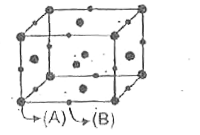Which of the following oxides have rock salt structure with coordination number 6:6?
BeO
MgO
CaO
SrO
The correct Answer is:B, C, D
To determine which of the given oxides have a rock salt structure with a coordination number of 6:6, we will analyze the properties of each oxide, particularly focusing on their crystal structures.
1. Understand Rock Salt Structure:
- The rock salt structure is characterized by a face-centered cubic (FCC) lattice. In this structure, each ion is surrounded by six oppositely charged ions, leading to a coordination number of 6:6.
2. Identify the Oxides:
- The oxides in question are Beryllium oxide (BeO), Magnesium oxide (MgO), Calcium oxide (CaO), and Strontium oxide (SrO).
3. Analyze Beryllium Oxide (BeO):
- Beryllium oxide has a different structure. Beryllium is small in size and forms a hexagonal close-packed (HCP) structure rather than an FCC structure. The coordination number here is 4:4, not 6:6. Therefore, BeO does not have a rock salt structure.
4. Analyze Magnesium Oxide (MgO):
- Magnesium oxide has a rock salt structure. It adopts an FCC lattice where Mg²⁺ ions and O²⁻ ions are arranged in a manner similar to NaCl, resulting in a coordination number of 6:6.
5. Analyze Calcium Oxide (CaO):
- Calcium oxide also exhibits a rock salt structure. Like MgO, it has an FCC lattice with a coordination number of 6:6.
6. Analyze Strontium Oxide (SrO):
- Strontium oxide similarly has a rock salt structure. It follows the same FCC arrangement as MgO and CaO, resulting in a coordination number of 6:6.
7. Conclusion:
- The oxides that exhibit a rock salt structure with a coordination number of 6:6 are Magnesium oxide (MgO), Calcium oxide (CaO), and Strontium oxide (SrO).
Final Answer:
The oxides that have a rock salt structure with coordination number 6:6 are MgO, CaO, and SrO.
- The rock salt structure is characterized by a face-centered cubic (FCC) lattice. In this structure, each ion is surrounded by six oppositely charged ions, leading to a coordination number of 6:6.
- The oxides in question are Beryllium oxide (BeO), Magnesium oxide (MgO), Calcium oxide (CaO), and Strontium oxide (SrO).
- Beryllium oxide has a different structure. Beryllium is small in size and forms a hexagonal close-packed (HCP) structure rather than an FCC structure. The coordination number here is 4:4, not 6:6. Therefore, BeO does not have a rock salt structure.
- Magnesium oxide has a rock salt structure. It adopts an FCC lattice where Mg²⁺ ions and O²⁻ ions are arranged in a manner similar to NaCl, resulting in a coordination number of 6:6.
- Calcium oxide also exhibits a rock salt structure. Like MgO, it has an FCC lattice with a coordination number of 6:6.
- Strontium oxide similarly has a rock salt structure. It follows the same FCC arrangement as MgO and CaO, resulting in a coordination number of 6:6.
- The oxides that exhibit a rock salt structure with a coordination number of 6:6 are Magnesium oxide (MgO), Calcium oxide (CaO), and Strontium oxide (SrO).
The oxides that have a rock salt structure with coordination number 6:6 are MgO, CaO, and SrO.
Topper's Solved these Questions
- BOOK - CENGAGE CHEMISTRY ENGLISHCHAPTER - S-BLOCK GROUP 2 - ALKALINE EARTH METALSEXERCISE - Exercises Single Correct82videos
S-BLOCK GROUP 2 - ALKALINE EARTH METALS
- BOOK - CENGAGE CHEMISTRY ENGLISHCHAPTER - S-BLOCK GROUP 2 - ALKALINE EARTH METALSEXERCISE - Exercises Assertion Reasoning17videos
S-BLOCK GROUP 2 - ALKALINE EARTH METALS
- BOOK - CENGAGE CHEMISTRY ENGLISHCHAPTER - S-BLOCK GROUP 2 - ALKALINE EARTH METALSEXERCISE - Exercises Linked Comprehension42videos
S-BLOCK GROUP 2 - ALKALINE EARTH METALS
- BOOK - CENGAGE CHEMISTRY ENGLISHCHAPTER - S-BLOCK GROUP 1 - ALKALI METALSEXERCISE - Archives Subjective8videos
S-BLOCK GROUP 1 - ALKALI METALS
- BOOK - CENGAGE CHEMISTRY ENGLISHCHAPTER - SOME BASIC CONCEPTS AND MOLE CONCEPTEXERCISE - Archives Subjective11videos
SOME BASIC CONCEPTS AND MOLE CONCEPT
Similar Questions
Which of the following contains rock salt structure?
View SolutionWhich of the following salt have lowest pH ?
View SolutionWhich of the following oxides has a three-dimensional structure ?
View SolutionIn which of the following structures, the anion has maximum coordination number?
View SolutionNiO adopts a rock - salt structure , The coordination number of the Ni2+ ion is
View SolutionIn the fluorite structure, the coordination number of cation is:
View SolutionWhich of the following does not have coordinate bonds ? .
View SolutionWhich of the following have been arranged in the decreasing order of oxidation number of sulphur ?
View SolutionWhich of the following statements is correct in the rock-salt structure of ionic compounds?
View SolutionFor a solid with the following structure, the coordination number of the point B is
 View Solution
View Solution

